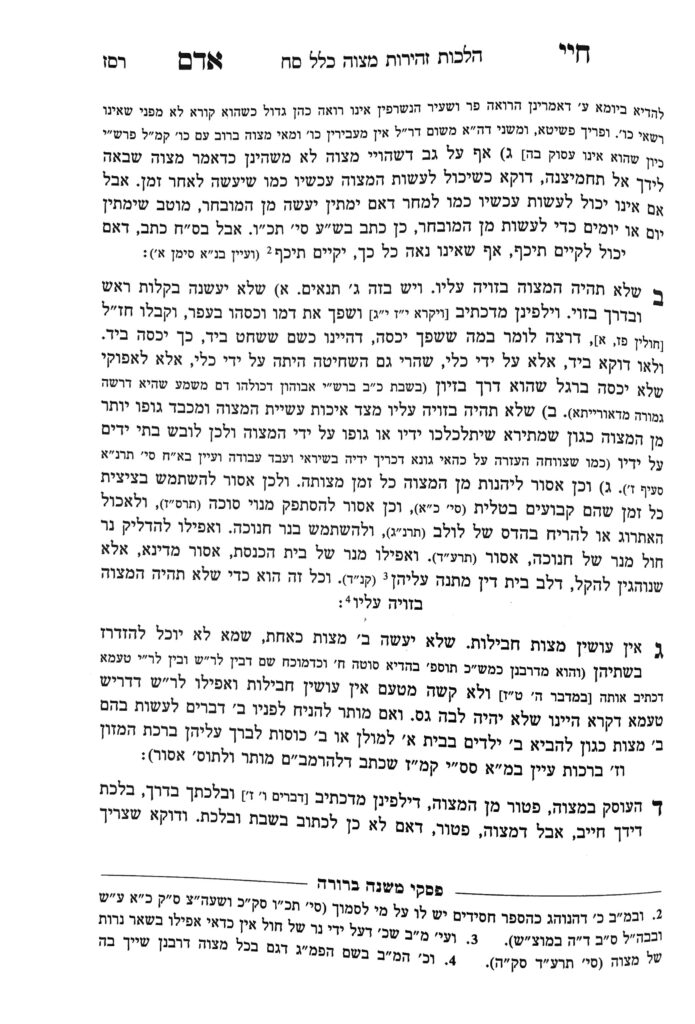We are continuing in siman 3, discussing the concept of ain osim mitzvos chavilos.
We left off with the Chayei Adam’s opinion that ain osim mitzvos chavilos is a din derabanan. The Gemara itself does not clearly state ain osim mitzvos chavilos is derabanan, but it is implied. We learned (shiur 1385) that Rav Shimon is doresh ta’ama d’kra, and one of the applications of his opinion would be that it is muttar to process two sotahs simultaneously if they are trembling. The Gemara then asks that according to Rav Shimon, it should still be assur due to ain osim mitzvos chavilos, and answers that there are two kohanim. The rishonim argue in understanding the Gemara’s answer
Rashi and Tosfos understand that the Gemara’s answer is that there is one kohen processing each sotah (for a total of two kohanim), and they do so simultaneously and in the presence of each other. Because they are two different people, it would not be an issue of ain osim mitzvos chavilos. However, if one kohen were to do both sotahs, one after the other, it would be a problem of ain osim mitzvos chavilos. Although the mitzvos are not being done simultaneously, simply setting both mitzvos up together is considered ain osim mitzvos chavilos.
The Magen Avraham concludes from Rashi and Tosfos that if a father has twin boys who are receiving their bris on the same day, bringing the children in at the same time would be a problem of ain osim mitzvos chavilos.
The Magen Avraham takes it a step further, and points out that according to Rashi and Tosfos, on days when more than one sefer torah is needed for kriyas hatorah, it would be a problem of ain osim mitzvos chavilos to take out the sifrei torah at the same time. Rather, the correct procedure would be to take out the first one, use it, return it, and then take out the second one. This procedure is the conclusion of the Yerushalmi as well. The Rema paskens to take them out at the same time, which is the prevalent minhag.
According to the Magen Avraham, another application of this halacha would apply to sheva brachos. The minhag is to use two kosos for sheva brachos, due to the issue of ain osim mitzvos chavilos. According to this thought process, preparing the second kos at the beginning of benching at the same time as the first kos would also be an issue of ain osim mitzvos chavilos, and it should not be filled up until after benching, when it is needed.
The Magen Avraham points out that the language of the Tur in Even Haezer (siman 62) is in accordance with this procedure.
(The Shulchan Aruch disagrees, and holds that there is no concern of ain osim mitzvos chavilos in regards to sheva brachos, to the point that one may use the same kos for both birkas hamazon and sheva brachos.)
The Magen Avraham points out that the Rambam disagrees with this opinion. Be’ezras Hashem, we will clarify the Rambam’s opinion in the next shiur.
Summary
The Chayei Adam holds that ain osim mitzvos chavilos is a din derabanan, although others disagree with him.
The Magen Avraham understands (based on Rashi and Tosfos’ understanding of the Gemara) that preparing for two mitzvos simultaneously–even if not done simultaneously–is an issue of ain osim mitzvos chavilos.



